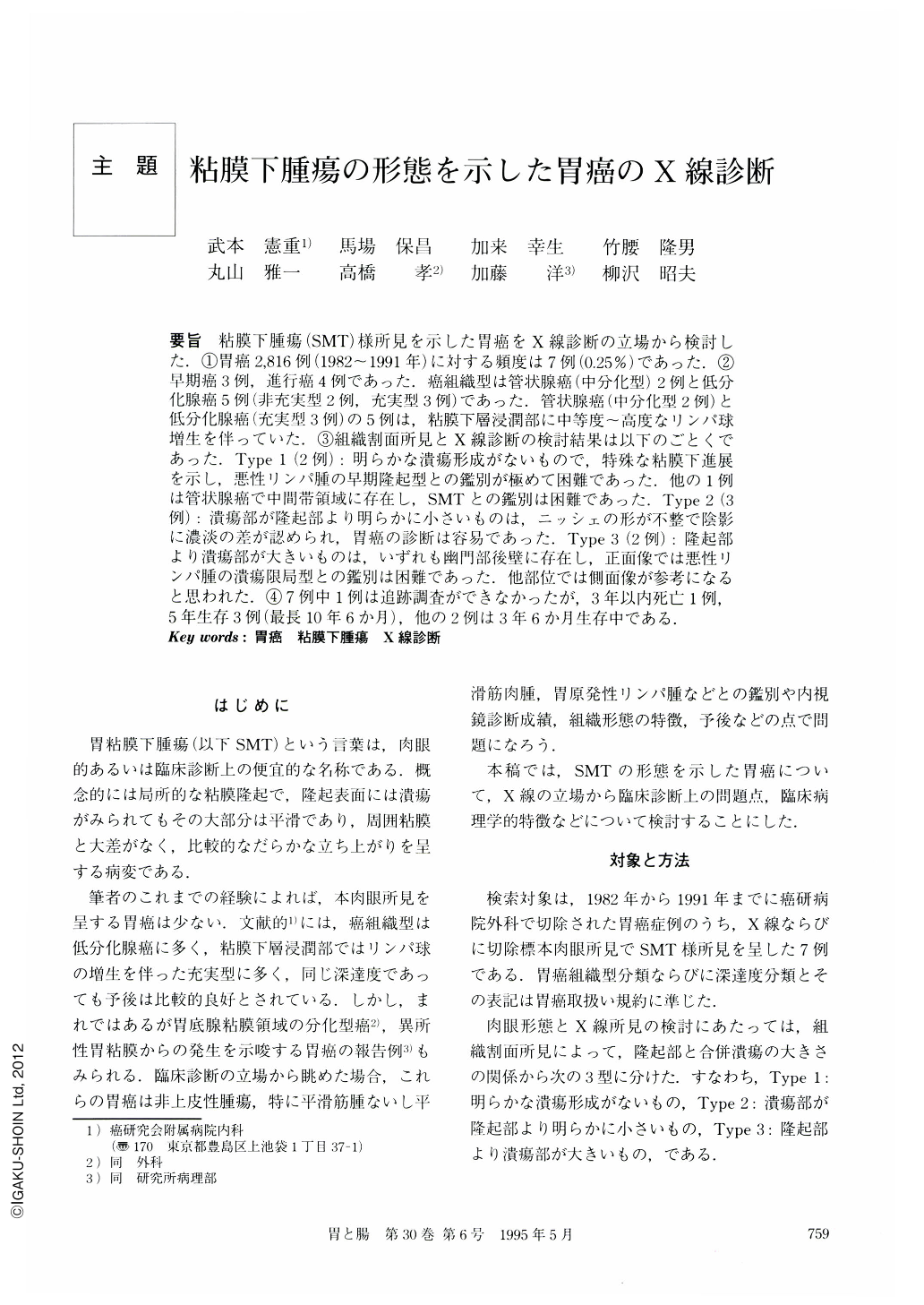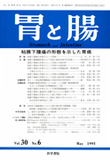Japanese
English
- 有料閲覧
- Abstract 文献概要
- 1ページ目 Look Inside
- サイト内被引用 Cited by
要旨 粘膜下腫瘍(SMT)様所見を示した胃癌をX線診断の立場から検討した.①胃癌2,816例(1982~1991年)に対する頻度は7例(O.25%)であった.②早期癌3例,進行癌4例であった.癌組織型は管状腺癌(中分化型)2例と低分化腺癌5例(非充実型2例,充実型3例)であった.管状腺癌(中分化型2例)と低分化腺癌(充実型3例)の5例は,粘膜下層浸潤部に中等度~高度なリンパ球増生を伴っていた.③組織割面所見とX線診断の検討結果は以下のごとくであった.Type1(2例):明らかな潰瘍形成がないもので,特殊な粘膜下進展を示し,悪性リンパ腫の早期隆起型との鑑別が極めて困難であった.他の1例は管状腺癌で中間帯領域に存在し,SMTとの鑑別は困難であった.Type2(3例):潰瘍部が隆起部より明らかに小さいものは,ニッシェの形が不整で陰影に濃淡の差が認められ,胃癌の診断は容易であった。Type3(2例):隆起部より潰瘍部が大きいものは,いずれも幽門部後壁に存在し,正面像では悪性リンパ腫の潰瘍限局型との鑑別は困難であった.他部位では側面像が参考になると思われた.④7例中1例は追跡調査ができなかったが,3年以内死亡1例,5年生存3例(最長10年6か月),他の2例は3年6か月生存中である.
Gastric cancer which mimic submucosal tumor was evaluated from the standpoint of radiologic diagnosis. 1) There were seven cases of gastric cancer mimicking submucosal tumor (GCMST) out of 2,816 cases of gastric cancer (0.25%, during the periods of 1982 and 1991). 2) There were three cases of early gastric cancer and four cases of advanced one. Histopathologically, they consisted of two cases of tubular adenocarcinoma (moderately differentiated) and five cases of poorly differentiated adenocarcinoma (three cases of non-solid type and two cases of solid type) . In the two cases of tubular adenocarcinoma and three cases of solid type poorly differentiated adenocarcinoma, there was moderate or extensive lymphocyte infiltration in the submucosal layer. 3) Based on the evaluation of the cross section of the surgical specimen and radiologic diagnosis, GCMST was classified into three types. Type 1 (two cases): In one case, there was no obvious ulceration in the mucosa and unusual advance into the submucosa, it was very difficult to differentiate from early protruding type of malignant lymphoma. The other case was tubular adenocarcinoma whose main part was located in the intermediate area and was difficult to distinguish from a submucosal tumor. Type 2 (three cases): There was an ulceration which was smaller than the protruding portion. Irregular shape and uneven density of filling defects led us to diagnose them as gastric cancer easily. Type 3 (two cases) There was an ulceration which was larger than the protruding part. All lesions were located on the posterior wall in the antrum. Frontal view of the lesion resembled to that of limited ulcerative type of malignant lymphoma. Lateral view might be helpful if a lesion was located in the other area of the stomach. 4) Although we could not follow one out of seven cases long-term follow-up result was as follows: one case was dead within three years, three cases survived for more than five years (the longest survival time was 10 years and six months), and the other two cases survived for three years and six months.

Copyright © 1995, Igaku-Shoin Ltd. All rights reserved.


